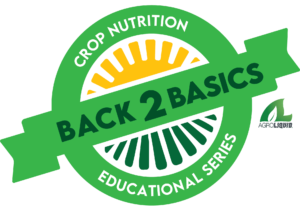Back 2 Basics
A Video Series from AgroLiquid
Copper

Copper is a vital micronutrient essential for chlorophyll production, reproduction, and overall plant health. Often called the “disease nutrient,” higher copper levels in plants are linked to better disease resistance. Copper acts as a catalyst for key enzyme processes and supports lignin development, which improves standability and stem strength. Because copper is the least mobile micronutrient in plants, deficiency symptoms typically show up first on new growth—yellowing leaves with possible necrotic spots and twisted tips.
Copper deficiencies often occur in high organic matter soils, where copper binds tightly to organic compounds and becomes less available to plants. Soil pH also affects availability: as pH rises above 7, copper binds more strongly to soil particles, limiting uptake.
Crops such as wheat commonly respond well to copper applications. Applying copper early in the season, preferably as a band application near roots, helps ensure uptake. Foliar applications are also possible but must be done cautiously to avoid leaf burn, especially when mixed with crop protection products.
Because copper can leach through the soil, proper management and timing of applications are key to maintaining healthy crops.


